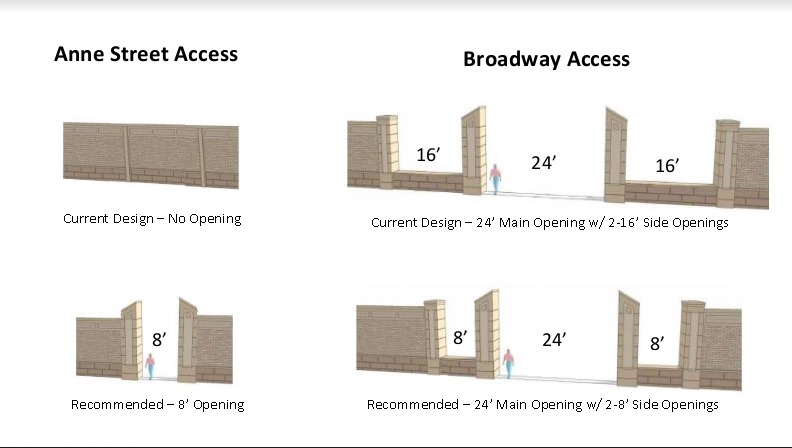Following last month’s City Council discussion and vote to add an opening in the Phase 1 floodwall at the Anne Street Bridge, I followed up with SRJB Project Administrator Ryan Ackerman regarding several topics that came out in that debate.
Most notably, I was concerned with the idea that removable floodwall structures were in some way less safe than concrete sections of floodwall. That is what I heard our Public Works Director tell members of City Council as they considered their vote, and if removable flood structures aren’t as inherently safe as permanent structures, that’s a problem that needs to be discussed prior to spending a billion dollars.
What follows is basically an email transcript of the questions I asked and the responses provided by Mr. Ackerman. Be warned, this is a long read, but it’s an informative look inside the inner-workings of our long-term flood protection efforts and the design aspects of infrastructure we hope will be a part of Minot for the next hundred years or longer.
The most interesting part of the transcript is in the very last paragraph. Again, all of this was in the context of adding an opening in the floodwall at the foot of Main Street so there was direct access to the Anne Street Bridge. My questions will be in bold, Mr. Ackerman’s responses are in italic.
My assumption — please correct me if I’m wrong — the development of engineering specs for a flood wall requires the discovery of load factors (probably based on height and water pressure), needed impact resistance, and likely many other considerations. Would you please go into the factors — in layman’s terms as much as possible — that go into engineering a flood wall?
The pedestrian opening at the Broadway Park — in terms of engineering requirements listed above — was that engineered to different load factors and standards than the concrete wall sections in the area?
R.A. With regard to the design criteria followed, permanent concrete floodwalls and temporary aluminum closures are designed to withstand similar conditions. The criteria that is used to design each is different because these are (obviously) different materials. As such, the approach to designing each is little bit different. Without getting too deep into the weeds, though, the summary is that the two material types could be used somewhat interchangeably with the caveat that temporary closures require human intervention during a flood fight at times in which the environment may not be very cooperative (snow, rain, ice, mud, etc.). Temporary closures always look easy to install in the manufacturer’s advertising, but the realities on the ground during a flood threat are typically much less forgiving. From a flood risk management perspective, temporary closures (sizes, locations, etc.) should be minimized.
In layman’s terms, does a removable opening result in a weaker wall and increased vulnerability to life and property?
R.A. That is somewhat of a loaded question that requires a two-part answer. They (concrete floodwalls and temporary aluminum floodwalls) are designed to withstand similar conditions, so it is not accurate to state that one installation would be weaker than another. However, the addition of temporary closures does increase risk since they take resources (time) to install during a flood threat.
At the November 2015 public input meeting regarding Phase 1 of Minot’s flood protection plan, Mr. Bentz referenced maintenance and the desire to reduce the number of overall openings as the sole reason for a single pedestrian opening. At the December 2016 Minot City Council meeting, Public Works Director Jonasson referenced concerns over the integrity of the flood wall and protection of life and safety as one of the reasons for a single opening. His quote from that meeting, “Every opening you add decreases the integrity of that floodwall. You don’t have a solid flood wall there, you have an opening that’s not as — I guess – not as safe as a solid flood wall.”
Mr. Jonasson’s statement contradicts Mr. Bentz’s statement from November 2015. Has new information or some other factor been discovered that might explain the contradiction?
R.A. The question of whether or not there is a contradiction between the statements is one of perspective. Mr. Jonasson’s statement regarding the solid versus temporary floodwall is accurate in that temporary openings take time to close during a flood threat, so it’s accurate to state that it’s ‘not as safe as a solid floodwall.’
There were some specific concerns about a design amendment to phase 1 at this point slowing down the project by “2, 3-years or more” — I would like to get an opinion from the Corp on the implications of a design amendment and what the the Corp’s process is for dealing with changes such as what was proposed by Alderman Straight.
R.A. The SRJB does have concerns with how plan modifications will impact the schedule for approvals. As the project has progressed through the design process, there have been modifications that have been made and addressed, and there are modifications currently being made based on the City’s acquisition plans related to the National Disaster Resilience Competition. The longer decisions take to make modifications to the plan, the greater the risk is to maintaining the schedule for the project. Getting approval from the USACE and other agencies is critical for moving flood protection forward in the basin. Getting the USACE approval is also critical for securing funding from the state and federal governments for the project.
Can you provide information on the legal agreement between the SRJB and the City of Minot with regards to the City having autonomy to guide our own flood protection plan and the bounds to which that autonomy extends, i.e. at what point or under what conditions would the SRJB insert themselves into plans being taken up by the City?
R.A. The City of Minot has the authority to direct the design of the features within the City of Minot, provided that the project is generally consistent with the Preliminary Engineering Report that was adopted by the SRJB and the City of Minot in 2012. The SRJB’s role is to provide overall project management, coordination and implementation. The City has a similar role (through the Public Works Director) but the scope is limited to the city of Minot.
In practice, it works as follows. Typically, a design coordination meeting is held twice per month to review progress on the various phases of the project. Attendees typically include the City SRJB representative (Dan Jonasson), the SRJB chairman (Dave Ashley), and three technical advisors (myself, Jerry Bents, and Jason Westbrock). When issues arise, they are discussed to identify the potential implications. In general, the technical advisors convey the facts, the decisions for the City of Minot are made by the City’s SRJB representative, and those decisions are informally ratified by the Chairman.
The plans continue to be developed and are submitted to the USACE at 30%, 60%, 90% and 100% design levels for comment. Comments are made by the USACE and addressed by the design teams. Concurrently, the designs go through an Independent External Peer Review and Safety Assurance Review by an outside consultant (HDR). Comments received from the independent reviewers are also addressed by the design teams. The design documents are also delivered to the members of the SRJB at the various design levels for review so that the members are up to speed with regard to the progress.
In general, the SRJB is looking at the bigger picture implications of decisions. Questions generally considered include:
Does a decision have a substantive impact on the performance of the system outside of the area in question? The SRJB is supporting a basin-wide, holistic solution that tries to achieve a balance of benefits and impacts.
Does a decision have a substantive impact on the budget for the project? The entire project is dependent on funding primarily (at this point) from the State Water Commission and the City of Minot. More costly solutions will deplete financial resources and cause the overall implementation schedule to be longer.
Once the plans are completed, they will be presented to the SRJB for formal approval prior to advertising for bids. In the past, the Public Works Director has also presented the plans for approval to the appropriate City of Minot committee and city council, as the city has financial obligations as the source of the local cost share for the project, basin-wide.
In the case of an additional pedestrian opening — how would the SRJB likely handle that?
R.A. Typically, design detail decisions are not forwarded to the SRJB for formal consideration. These decisions are made in the bi-weekly coordination meetings and conveyed to the agencies and board members through the design review process.
Since this would represent a change to the plan that has been contemplated, though, we would inform the SRJB members as part of a regular monthly update that is given to them regarding project status. If I recall correctly, Alderman Straight’s intent was to have Mr. Jonasson bring the issue before the SRJB with the City Council’s recommendation.
The City Council has acted to maintain a single pedestrian access in Phase MI-1 at Broadway. The City is responsible for the Operations and Maintenance of the project within the city limits of Minot, so the perspective of the City Council with regard to this particular issue (opening at Anne Street vs. no opening at Anne Street) is really important.
Obviously, I can’t speak to the hypothetical action that the SRJB would take.
And below is a from a follow-up email the next day.
Thank you for your detailed responses yesterday. I do have a couple follow ups. And if my questions reveal a basic lack of understanding, strike you as biased, or are unfair, please don’t hesitate to call those things out and elaborate as much as you want. I have nore restrictions on column inches, and my goal is to get to the best information available. And I don’t mind being told my assumptions are wrong if it helps everyone understand more clearly in the end.
All of this is based on my understanding of Mr. Jonasson’s recent comments which I understood as meaning removable flood walls are functionally inferior to concrete walls.
That’s a concern to me and to Minot as the flood protection project gets underway, so — first and foremost — I would like to reduce concerns on that front if possible.
So, if we remove the maintenance element from the equation and assume that in a flood threat all our closure structures were put into place properly and in a timely manner — is it fair to say that removable closure structures throughout town are designed so they are functionally equal to concrete floodwalls in their ability to hold back the water?
R.A. Provided that the removable closure structures are put in place prior to the flood waters lapping up against them, they are designed to perform just as a concrete floodwall would. Since the temporary columns and stoplogs are individual components, the closure is not a homogeneous material like a concrete wall is though. There will be some leakage that occurs at the interface of all the parts, especially as the gaskets of the components age. Any leakage that occurs will generally make its way to adjacent storm sewers to eventually be pumped into the river during a flood threat, so this is an anticipated and manageable phenomenon. I believe the fundamental premise of Mr. Jonasson’s concerns are related to the risk of having to rely on the human intervention associated with the installation of the closures.
In one of your responses yesterday, you reference the addition of closure structures as increasing risk because they take time and resources to install. By extension, do project engineers also evaluate the risk associated with an opening in terms of the operational requirements of putting the closure structure in place during a flood threat? In other words and in a general sense — is a bigger opening a higher risk than a smaller opening because it requires more time, labor, equipment, and component pieces?
R.A. In short, larger openings equate to larger risk. Please understand that risk is not a binary relationship. All elements and decisions carry a certain amount of risk. Risk is qualitative and generally subjective. In other words, most decisions made during the design process have an impact on the risk ‘needle’. A larger opening versus a smaller opening would move the risk ‘needle’ higher. Likewise, two openings versus one would move the risk ‘needle’ higher.
You also stated that closure structures should be minimized to decrease risk, has there been a general effort to minimize the size of openings as well and what are the general factors that went into determining the size and location of each opening so far?
R.A. From a flood risk management perspective, closure structures should be minimized. That desire, however, needs to be balanced with planning perspectives and public input. The lowest risk alternative from a flood risk management perspective is no closures at all. However, that is not practical given the project objectives.
Openings are considered at each location the levees or floodwalls cross a road, railroad or trail. Options typically exist to provide an opening through the feature, reconstruct the transportation corridor to go ‘up and over’ the feature, or otherwise reroute the transportation corridor to consolidate the number of required openings or crossings.
The minimum size of the opening is determined based on the functional needs for the opening. In the case of the Broadway opening, a width of 24’ was chosen to allow for larger construction equipment to access the wet side of the floodwall. The intent of the designer was to keep the openings in 8’ increments so that the components could be somewhat standardized. There were some concerns associated with a 16’ opening and the potential for larger vehicles to strike the edges of the opening and damage it, so the opening was enlarged to 24’ with the belief that the increased risk associated with a larger opening would be offset by the reduced risk of having the structure accidentally damaged during maintenance activities.
The side or flanking openings at the Broadway opening were added purely for aesthetics. In this instance, the flood risk was being balanced with the desire to make the opening more appealing to the public and users of a future greenway or waterway. During the design process, the City was also considering the property at 338 Walders Street as a potential visitors or interpretive center for the greenway or waterway. The Broadway access is located adjacent to this structure, so it was determined that the opening should have additional aesthetic character.
We acknowledge that the project will significantly change the landscape of the community and that it will exist in non-flood situations a vast majority of the time. Our duty is to design and deliver a project to the community that will reduce the risk to life loss and property damage in the event that a flood similar to the 2011 flood ever occurs again.
It is reasonable to question the size and location of the openings – this is not an exact science. Ultimately, the engineers and operations personnel use their best judgment based on all known factors to recommend the locations for the placement and configuration of the openings. The design recommendations are reviewed with the project sponsor on a regular basis and ultimately the decisions are confirmed by the official bodies (SRJB and City of Minot) and approved by the regulatory agencies (USACE) prior to the project being advertised for bids and constructed. One element of the project and the subject of your articles was recently considered by the Minot City Council. The Council elected to keep the configuration of the openings as designed.
It seems to me that Alderman Straight’s proposal — though it did add another opening (added operational risk) — also created some maintenance and operational gains (and thereby lowered operational risk) because it reduced the size of the flanking openings at Broadway from 16’ to 8’. Is that a reasonable conclusion?
R.A. That is a reasonable conclusion. Exactly how much the risk ‘needle’ moved one way or another is subjective. It seems that the City Council was weighing that consideration in their deliberations and subsequent actions.
Getting right down to the literal nuts, bolts, stoplogs, and vertical pillars of the removable structure at Broadway, can you provide a comparison of what is required in the current plan versus what would be required had Alderman Straight’s proposal been successful?
R.A. There are multiple manufacturers that would typically meet the required specifications for these types of closures. For consistency, let’s make the assumption that the components will be similar to those being utilized at the new closure structures at the Minot water treatment plant. The stoplogs being being utilized at the water treatment plant project are 8” tall.
For the current design opening at Broadway, there would be 4 temporary columns installed, followed by approximately 63 stoplogs in the main 24’ opening and 60 stoplogs in the 16’ flanking openings for a total of approximately 123 stoplogs.
Under Alderman Straight’s proposal, there would be 2 temporary columns installed, followed by approximately 63 stoplogs in the main 24’ opening and 30 stoplogs in the 8’ flanking openings for a total of approximately 93 stoplogs.
Additionally, under Alderman Straight’s proposal, there would be approximately 24 stoplogs installed at the proposed opening near the Anne Street Bridge. That assumes an 8’ opening, which would have to be vetted to determine if it was adequate based on the proposed use (sidewalk or shared use path) and also the minimum width for maintaining the opening as well.
Obviously, the number of locations to operate and maintain increases by one with the addition of the Anne Street Bridge opening. It needs to be noted that these are cursory / preliminary estimates for the Anne Street Bridge opening. There has been no design performed for this feature.
From a flood risk management perspective, these options are similar with some gains and some losses. The number of temporary columns decreases by 2. The number of stoplogs decreases by approximately 6. The number of locations to manage increases by 1.
The table below summarizes the statistics: (the table was provided by Mr. Ackerman)
| Current Design | Alternate Configuration | |
| Broadway Opening Size | One 24′ Wide x 13.5′ Tall Primary Opening | One 24′ Wide x 13.5′ Tall Primary Opening |
| Two 16′ Wide x 10′ Tall Secondary Openings |
Two 8′ Wide x 10′ Tall Secondary Openings |
|
| Anne Street Opening Size | No Opening |
One 8′ Wide x 16′ Tall Opening |
| # of Temporary Columns | 4 |
2 |
| # of Stoplogs (Approx.) | 123 | 117 |
| # of Locations | 1 | 2 |




